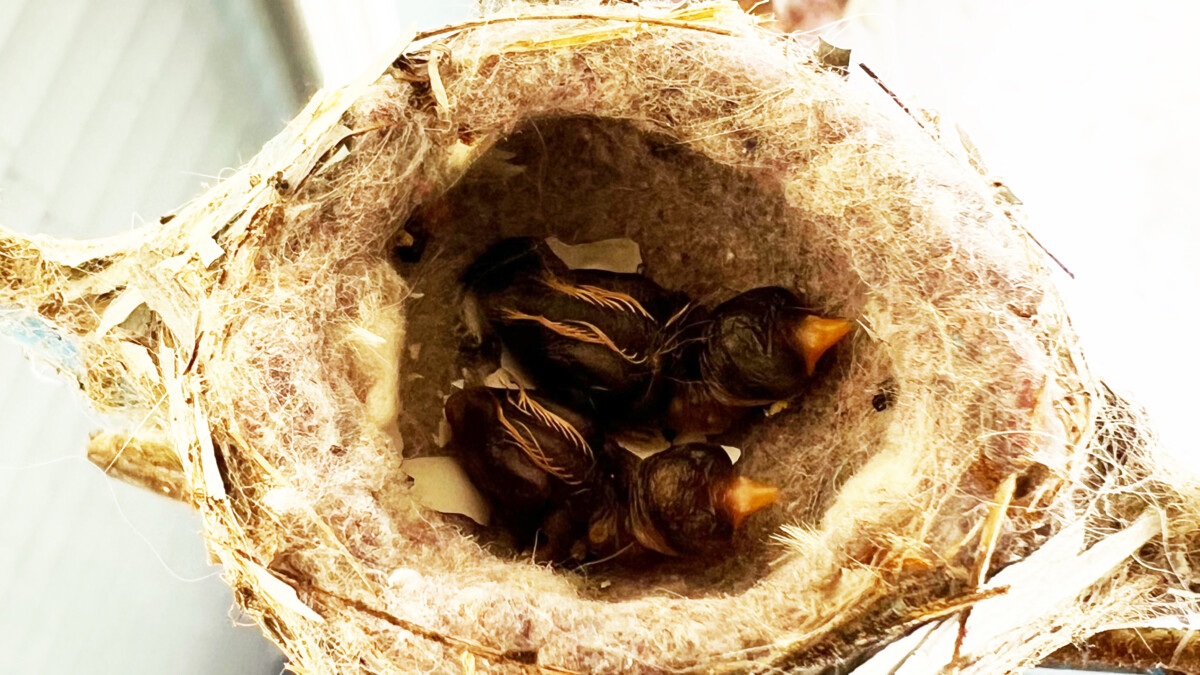This post contains affiliate links.
Every evening, my feeders are heavily visited by many hummingbirds who are simultaneously filling their bellies before retiring for the night.
That made me wonder where all those hummingbirds go to sleep for the night.
- Do they sleep together like chickens?
- Do they sleep in nests like many breeds of birds?
- Do they sleep upside down like bats?
- Do they sleep in the same place every night?
This article shares the information I learned regarding the questions above.
Where do hummingbirds sleep?
Hummingbirds sleep on the downwind side of sheltered trees on branches with foliage that protects them from cold winds and the elements after sunset. They enter torpor, which significantly reduces their metabolism. The exception is the nesting hummingbird mother, who sleeps in the nest with her babies.
Hummingbirds, those enchanting aerial acrobats, hold a secret nighttime routine that is just as captivating as their daytime displays.
After their bellies are full and the sun begins to set, these tiny birds retreat to cozy, sheltered spots among the leaves and branches of trees and bushes to protect themselves from the elements and predators.
Since hummingbirds require an intake of nutrition every 20 minutes, one would wonder how they survive through the night. To counteract this dilemma, the hummingbird has the ability to go into torpor, a condition different from sleep where metabolism slows down and their body temperature falls during this type of mini-hibernation.
For more information on torpor, see my article: Hummingbird Slumber: The Secret to Conserving Energy at Night.
Now, you might be wondering where exactly they find these nightly hideaways. Hummingbirds have a preference for trees like oak, birch, and poplar. These trees offer ample sheltered spots in their abundant branches and leaves.
Their solitary nature extends to their sleeping habits with isolated roosting.
The exception is the nesting hummingbird mother who sleeps in the nest with her babies.
Although hummingbirds are not typically nocturnal, there are some exceptions:
- During the migration season, some brave souls undertake nighttime flights crossing the Gulf of Mexico.
- In warmer climates or areas illuminated by artificial lights, you may spot a few night feeders. Still, this behavior is rare and more of an exception than a rule.
The next time you marvel at these jewel-like creatures flitting around during the day, know that they have their own enchanting nighttime routine. As the sun dips below the horizon, hummingbirds find their hidden spots among the trees, embracing the magic of torpor and ensuring they wake up refreshed and ready to paint the sky with their dazzling displays once more.
Do hummingbirds sleep upside down?
Hummingbirds do not intentionally choose to sleep upside down as this is not their standard sleeping position, however, during torpor, they can accidentally slip into an upside-down hanging position and continue to sleep in that position while still tightly gripping onto their perch.
Hummingbirds do not intentionally sleep upside down, however in the catatonic state of torpor, they can accidentally fall forward or backward and remain in that position for the rest of the night.
Hummingbirds enter a state of rest called torpor, which is a deep sleep-like state that allows them to conserve energy during the night or when the weather is unfavorable. During torpor, their metabolic rate and body temperature drop significantly, helping them survive when food sources are scarce or weather conditions are challenging.
A hummingbird’s heart typically races at a staggering 1200 beats per minute while awake. During torpor, however, it slows down to a mere 50 beats per minute! They cling to tree branches tucking their heads and fluffing their feathers for warmth. Sometimes, during torpor, they might hang upside down like a tiny delicate bat.
Hummingbirds occasionally hang upside down while they sleep even though they typically perch upright to sleep. When in torpor, they are not exerting any energy to maintain their balance. If the perch is especially smooth, they could accidentally slide forward or backward and land upside down.
This movement won’t cause them to awaken while they are in a deep state of torpor. Their feet are clinging so firmly; they will keep sleeping upside down and won’t fall.
Just leave a hummingbird alone if you notice it perched upside down on your feeder. Most likely, it is dormant and will awaken on its own. You might wish to move it to a safer location in the unusual event that it falls to the ground.
It takes hummingbirds as little as 20 minutes or up to an hour to fully awaken from this deep torpor slumber.
For more information about torpor, see my article: Hummingbird Slumber: The Secret to Conserving Energy at Night.
Do hummingbirds sleep in nests?
Hummingbirds do not sleep in nests with the exception of hatchlings and mothering hummingbirds. During the breeding season, the female hummingbird will sleep in her nest to incubate the eggs or keep hatchlings warm.
Hummingbirds generally perch solo on a tree or bush limb when sleeping.
Unlike many bird species that settle into cozy nests for a restful night, hummingbirds generally do not sleep in nests at night. Female mothers incubating their eggs, warming their hatchlings or young birds that have not yet fledged the nest are exceptions.
Males hummingbirds avoid nest sleeping at all times.
Female hummingbirds also do not sleep in a nest unless she has laid their eggs and is raising their babies.
Instead of sleeping in nests, hummingbirds find a sheltered spot such as a branch or a dense area on the downwind side to enter torpor when it is time to sleep. Torpor is a deep, energy-conserving sleep that allows these small birds to survive the night with minimal energy expenditure.
Females build nests primarily for breeding and raising their young. The female builds a nest when she is ready to lay her eggs. To ensure that her eggs and or hatchlings do not get cold or are victim to predators the female hummingbird will constantly stay in her nest including the night with the exception of leaving the nest to feed and bring food back to the hatchlings.

Hatchlings, not ready to become fledglings, sleep in the nest constantly. The female hummingbird will sleep close to the nest but not in the nest when she sees that her babies are close to becoming fledglings. After the fledglings are successful, they will perch and sleep close to the nest but not return to the nest at night to sleep.
Therefore, the general rule of thumb is that hummingbirds perch and torpor at night and do not sleep in a nest unless it is a hatchling, a fledgling-to-be, or a mother caring for her babies.
Do Hummingbirds Sleep in the Same Place Every Night?
Hummingbirds generally do not sleep in the same place every night with the exception of hatchlings and mothering hummingbirds which sleep in the nest. After hatchlings fledge, they and their mothers perch near the nest for 3-4 weeks. Thereafter, the fledglings adopted their own individual pattern.
In general, hummingbirds do not exhibit consistent nocturnal roosting behavior and lack fixed nesting areas. An exception to this is the nesting mother hummingbird with her brood and/or the hatchlings that live daily in the same nest until they fledge.
Once they fledge, the fledglings may roost close to the nest where they hatched and spent the past 3 weeks growing, but will not return to the nest. The mother hummingbird will roost in the area close to her fledglings for the next 3 weeks while she feeds and secures their safety.
Hummingbirds have an amazing memory. They can remember every flower and when they last visited it for the entire duration of migration which can cover up to 3,000 miles.
During the summer and winter migrations, which can each be up to a month or more; they perch in different locations because they are traveling to new locales daily. In these circumstances, they may in fact remember areas or trees that they had previously perched and return to the same spots for the night.
During periods of non-migration, they use this remarkable memory to earmark safe places they have previously perched. Although they do not sleep in the same place every night, they do remember the bush or tree from the night before and may return to perch in the vicinity or on a different branch from their previous location.
Their nighttime perching choice will be affected by their memory, weather, food availability, and environmental conditions.
Hummingbirds do not sleep in the same place every night, however, due to their keen memory they may return to the same location for their nightly rest.
For more information on hummingbird memory, see my article: Hummingbird Adaptation and Remarkable Ability to Locate Food
What Time do Hummingbirds go to Bed?
Hummingbirds’ bedtime coincides with sunset. Hummingbirds go to bed as early as 4:15 pm in the southernmost city in the USA on the shortest day of the year; as late as 9:15 pm in the northernmost city in the contiguous USA on the longest day of the year.
As you question what time hummingbirds go to bed, consider the time of year, geographical location, and current environmental factors.
Consider the location within the United States and the sunset differential between the summer and winter solstice. The variation ranges from as early as 4:15 pm to as late as 9:15 pm depending on the day of the year. The exact bedtime will vary daily as the daylight becomes longer or shorter throughout the year.
As diurnal creatures, hummingbird bedtime is closely linked to the circadian cycle and daylight hours. They begin their nighttime resting behavior at dusk as natural daylight diminishes.
When the sun starts to set and darkness begins to settle, hummingbirds will begin their process of getting ready for bed by feverishly feeding and filling their bellies before searching for a safe and sheltered place to spend the night.
During this time, they will find a perch in trees, shrubs, or other vegetation downwind that provides them with protection from predators and exposure to the elements.
The exact time the hummingbirds go to bed varies based on location, season, and local environmental conditions such as food availability and weather.
Most hummingbirds begin the nighttime routine shortly after sunset however it is possible to see hummingbirds jetting around after dark as they look for a suitable protected location for the night.
Here’s wishing you an opportunity to observe a hummingbird in torpor at some point in your life, and if really lucky, to see one hanging upside-down!
Happy Hummingbird Watching
Check out my other posts on Hummingbird Questions
Backyard Visitors participates in affiliate programs which compensate us for referring traffic.


